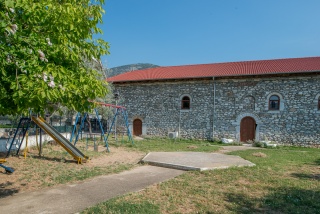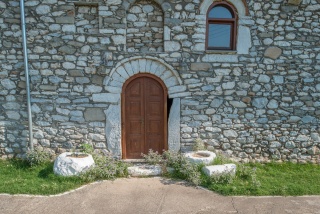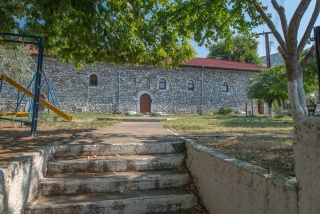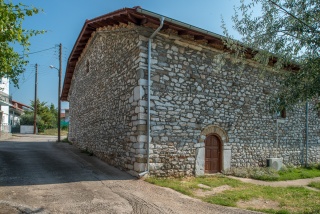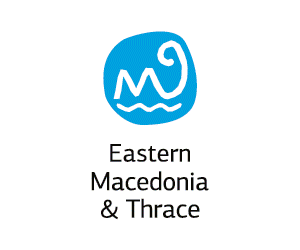Traveler's Guide
East Macedonia & Thrace
Holy Church of Holy Mary - Old Churc

The Holy Church, named as the "Old Church" is dedicated to the Entrance of Holy Mary, honored on November 21. The oral testimonies of the residents report that the post-Byzantine church of Panagia was built in 1835 during the prelacy of the Metropolitan Germanos B of Drama (May 1831 to 22 November 1835) and is said that the holy temple was inaugurated in 1832, where the "Greek Priest" was officiating or from 1843 to 1851 according to a letter of Saint Chrysostom, Metropolitan of Drama - Smyrni, to the Holy Ecumenical Patriarch of Istanbul Ioakeim C, dated at May 7, 1907, in which he says that it was erected by subscriptions and personal work of the orthodox Christians Plefnas, during the orthodox Metropolitan Athanasios Kairi of Drama, who ascended to the Metropolitan throne of Drama from 1842 to 1852. However in the pottery inscription on the south side, just above the entrance of the Holy Church are preserved only the first two digits 18.. The church is a three-aisles basilica where the aisles are separated from each other, with large Roman and Byzantine sculptures in its stone built masonry, with 30m. length and 15m. width and 38 windows (by the testimonials). Worked as an Orthodox Patriarchal Church until 1880. During the prelacy of German C. The famous Greek priests who functioned the church were: Christos Papaioannou, the priest Stogiannis from Trikala of Thessaly, Panagiotis Sempanis the last Athanasios Papastergiou. Historical events are associated with the temple, from the period 1870-1912 during which many Byzantine churches were made Bulgarian Exarchist, and this one was occupied by Bulgarians who were bringing priests from Bulgaria as the priest-Arsene, the priest Triantafyllos and the preacher Sfetko. In 1869 the Bishop of Drama Agathangelos in order to avoid bigger episodes in Petroussa, initially allowed exarchikos priests to operate on one Sunday and Greek Patriarchal on the next one. From 1880 the patriarchal expelled from the church and built a new one, that of Saint Athanasius. Petroussa until the begging of the Balkan wars in 1912 -1913 suffered from violence, and its people were forced to learn the Bulgarian language and history. After 1912 the allied forces attack against the Turks. In Drama the Bulgarians send the 7th Division. The entire state benefits komitaji who attack the Turkish army to help the Bulgarian army to fully occupate the area. The temple was burned by the Turks in 1912, but Bulgarians komitaji Daef and Panitsas were fortified in this, and hindered the passing Turkish armies. So the Turks turned their firearms against the church resulting in its total destruction. It is said that the verger of the church was also burned at that day. Unfortunately, the burned church of Petroussa did not reintegrated in 1912 with the Patriarchate. In 1967 during the inventory of the real estates in the prefecture of Drama, the space formulated as "communal land"" (old church). During the period of blessed Dionysios the belfry of the old church was destroyed. We know from older people that the church was a place sor pray even after its destruction, and the faithfuls of Petroussa light up its candles every day in the Sanctuary, begging that someday their temple is built again. The place that the church is located has received interventions by community"s efforts to be used as multifunctional hall and a folk museum. During the memorable Mayor George Makris the old Church of Holy Mary had entered into a co-funded program of the European Union so as to be restored and embellished and to regenerate its surrounding area. The old wall paintings were not well preserved after the fire and it remained roofless for a century or even more. Oral testimonies of local people say that they remember that some parts of the walls showed bodies of angels. Today the church is roofed and restored. The eastern part where there is the Sanctuary of the Church, is separated from the remaining building and a chapel remains, where the faithful can light a candle and pray to the Virgin Mary. The wall paintings inside the niches are recent. The department continues to operate as a sanctuary and is accessible all day long and worships are performed in it. The western section is the place that the most intervention have been done and it is closed. The floor have been marbled, and the walls werw plastered. Outside the church is covered with a new roof and wooden window frames have been added on windows and entrances.
Management Body: Holy Metropolis of Drama
Tel. +302521032362
Address
No information available.Contact Information
No information available.
